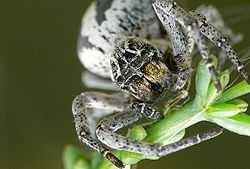Stegodyphus lineatus
| Stegodyphus lineatus | |
|---|---|
 | |
| Scientific classification | |
| Kingdom: | Animalia |
| Phylum: | Arthropoda |
| Class: | Arachnida |
| Order: | Araneae |
| Suborder: | Araneomorphae |
| Family: | Eresidae |
| Genus: | Stegodyphus |
| Species: | S. lineatus |
| Binomial name | |
| Stegodyphus lineatus (Latreille, 1817) | |
| Synonyms | |
|
Eresus lineatus | |
Stegodyphus lineatus is the only European species of the spider genus Stegodyphus.
Description
Males are up to 12 mm long, females up to 15 mm. The colour can range from whitish to almost black. In most individuals the opisthosoma is whitish with two broad black longitudinal stripes. Males and females look similar, but the male is generally richer in contrast and has a bulbous forehead.[1] The species name refers to the black lines on the back of these spiders (not present in all individuals).
Behaviour
These spiders build a web between twigs, mostly of low thorny shrubs. The web has a diameter of about 30 cm and is attached to a retreat made out of silk and covered with debris and food remains. Retreat is a cone-shaped structure about 5 cm long, which has an entrance at one end. The spiderlings hatch in this retreat, being released from their cocoon by their mother and then protected by her for a further two weeks. Adult males can be found in spring.
Offspring are matriphagous meaning they eat their own mother. Females can mate with several males (polyandry). While females may gain some benefits from multiple matings,[2] overall polyandry is costly [3] and mated females are often aggressive towards males (also see below). Males may chance upon only one or two mates in their entire lifetime. Egg sacs are lost quite frequently due to predation by ants and females are able to lay another clutch if they lose their first. This represents an opportunity for males, however, who can secure themselves a mate by simply disposing of her offspring (this can occur because some males are still seeking mates when most females have already laid). Males go about this by detaching the egg sac with their chelicerae, moving it to the entrance, then simply tossing it to the ground.[4]
This behaviour, known as infanticide, is not so straightforward for females however. Female fitness is greatly reduced by the loss of their young, with the female being less likely to survive until her next lot of offspring can hatch, as well as having fewer eggs the second time. Their offspring also hatch later in the season and are less likely to thrive themselves. With this in mind, it comes with little surprise that females aggressively attend to their nest, chasing off around half the males that come nearby.[4] Males can sustain injuries in these battles with the larger females, and in some cases the female not only kills, but eats the male intruder. For males however there is little option but to take this risk, resulting in sexual conflict that sees around 8% of egg sacs destroyed.[5]
The act of reproduction, regarding the female, leads to an increase of digestive enzymes allowing her to eat more preys and do more stock nutrients. Digestive enzymes starts to digest the inside of the organism, except for the heart, the guts and mostly ovaries. Once the offspring is born, and until the mother die, the mother regurgitates for two weeks inside stocked fluids as really nutritive food for the progeny. 95% of the mother's mass is digestated by the offspring. They will grow three times their size between their birth and their dispersion. [6]
Distribution
S. lineatus occurs in Europe only in the southern Mediterranean region (south of Barcelona, southern Greece including Crete) and stretches up to Tajikistan.
Footnotes
References
- Schneider, J.M. & Lubin, Y. (1996): Infanticidal male eresid spiders. Nature. 381: 655-656.
- Bellmann, Heiko (1997): Kosmos-Atlas Spinnentiere Europas. Kosmos. ISBN 3-440-10746-9
- Arnqvist, G. & Rowe, L. (2005): Sexual conflict. Princeton University Press, Princeton ISBN 0-691-12217-2
- Maklakov, A.A. & Lubin, Y. (2006): Indirect genetic benefits in a spider with direct costs of mating. Behavioural Ecology and Sociobiology. 61: 31-38.
- Maklakov, A.A. et al. (2005): Sexual conflict in the wild: elevated mating rate reduces female lifetime reproductive success. American Naturalist. 165: S38-S45.
| Wikimedia Commons has media related to Stegodyphus lineatus. |